HI6005 - Management & Orgs: Cross-Cultural Teams Report
VerifiedAdded on 2022/09/14
|10
|4495
|13
Report
AI Summary
This report delves into the complexities of cross-cultural teams within the context of global business. It begins by defining cross-cultural teams and outlining their key features. The report then examines the challenges faced by expatriate managers, using Hofstede's model of national culture to analyze cultural differences and their impact on team dynamics. It highlights the crucial skills and abilities required for successful international managers and explores how multivariate analysis can aid in the recruitment process. The report also discusses acculturation issues related to expatriation and repatriation. The assignment covers topics like team management, cultural differences, and the implications for effective leadership in a global environment. The report aims to provide insights into managing diverse teams, improving communication, and enhancing overall team performance in a global business setting.
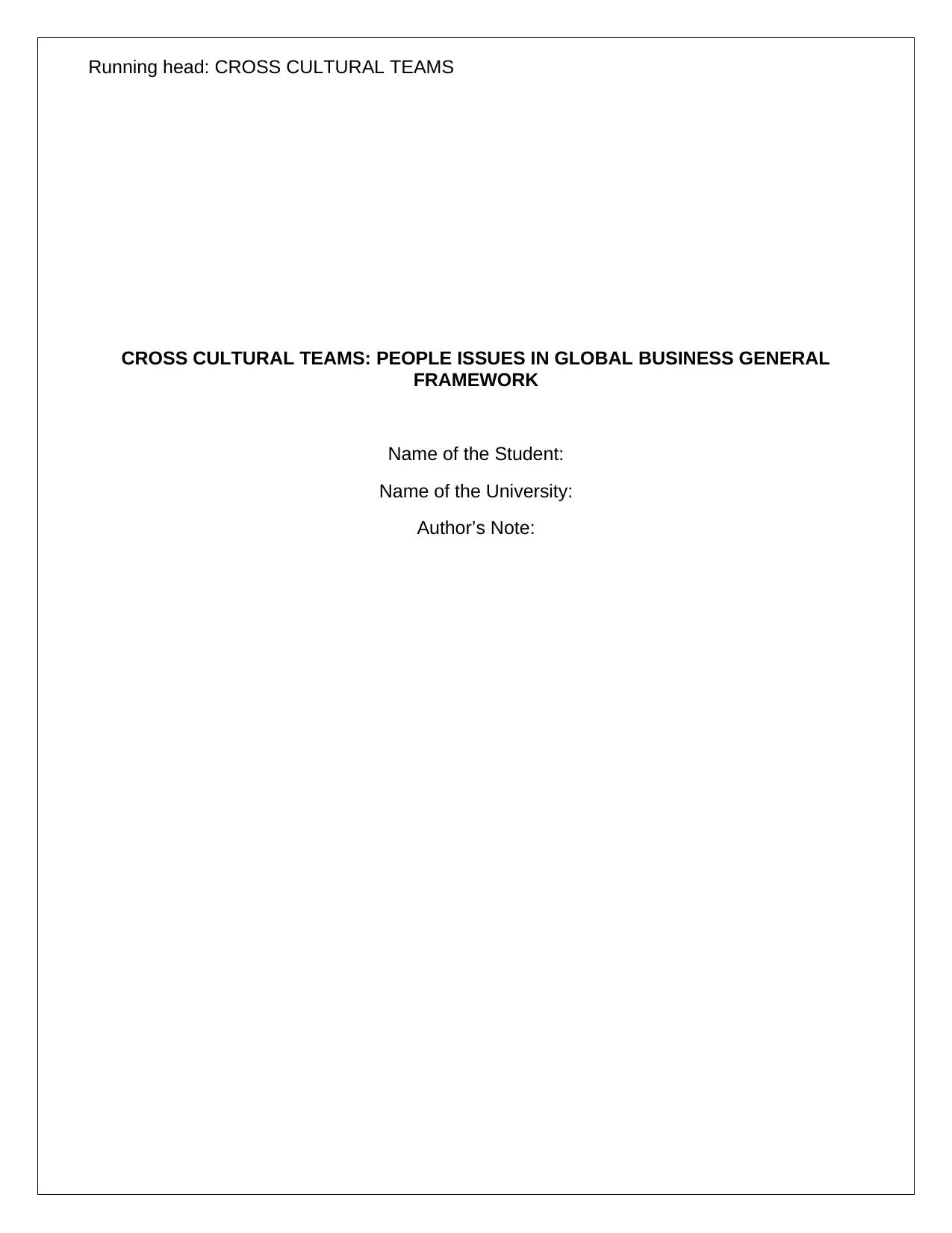
Running head: CROSS CULTURAL TEAMS
CROSS CULTURAL TEAMS: PEOPLE ISSUES IN GLOBAL BUSINESS GENERAL
FRAMEWORK
Name of the Student:
Name of the University:
Author’s Note:
CROSS CULTURAL TEAMS: PEOPLE ISSUES IN GLOBAL BUSINESS GENERAL
FRAMEWORK
Name of the Student:
Name of the University:
Author’s Note:
Paraphrase This Document
Need a fresh take? Get an instant paraphrase of this document with our AI Paraphraser
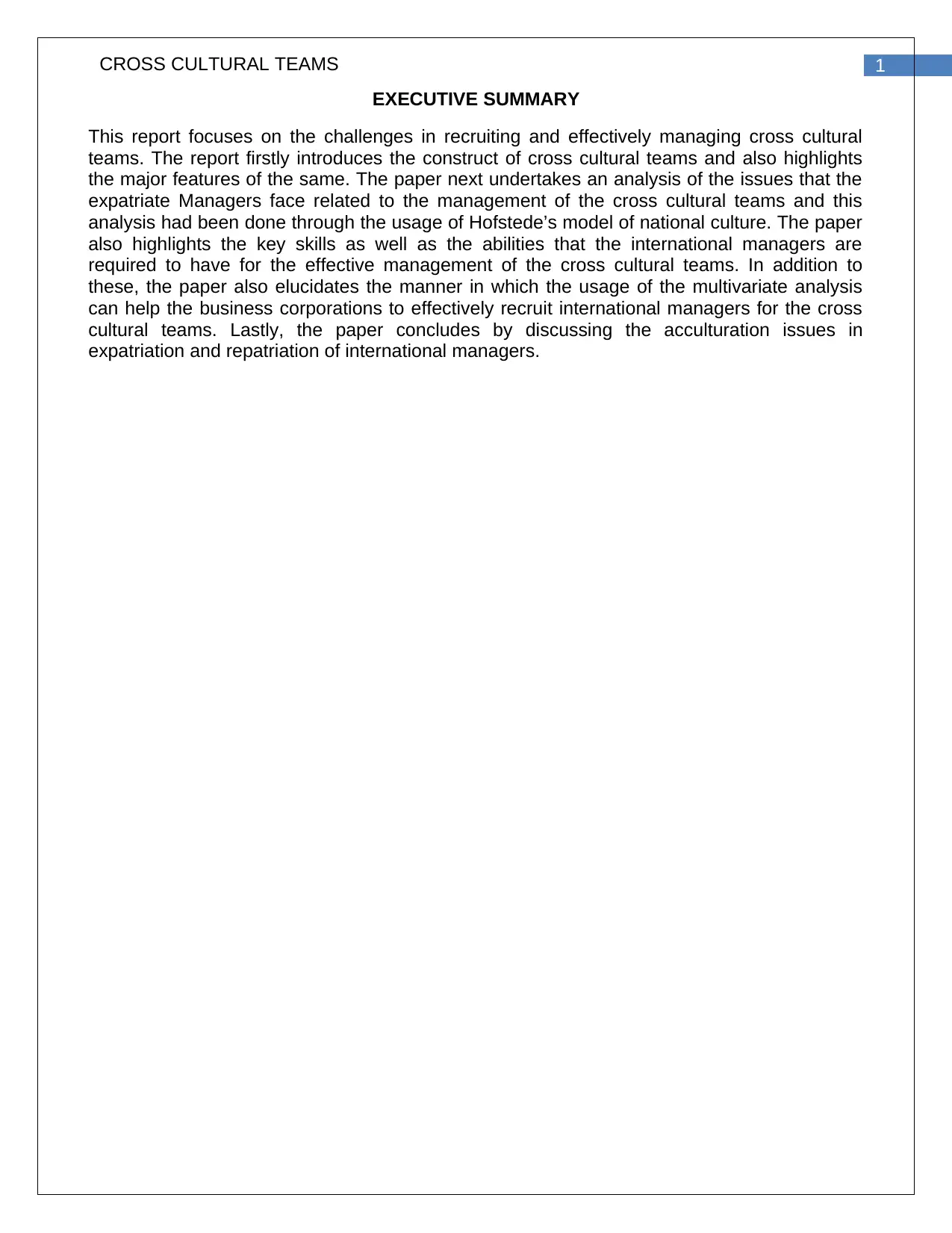
1CROSS CULTURAL TEAMS
EXECUTIVE SUMMARY
This report focuses on the challenges in recruiting and effectively managing cross cultural
teams. The report firstly introduces the construct of cross cultural teams and also highlights
the major features of the same. The paper next undertakes an analysis of the issues that the
expatriate Managers face related to the management of the cross cultural teams and this
analysis had been done through the usage of Hofstede’s model of national culture. The paper
also highlights the key skills as well as the abilities that the international managers are
required to have for the effective management of the cross cultural teams. In addition to
these, the paper also elucidates the manner in which the usage of the multivariate analysis
can help the business corporations to effectively recruit international managers for the cross
cultural teams. Lastly, the paper concludes by discussing the acculturation issues in
expatriation and repatriation of international managers.
EXECUTIVE SUMMARY
This report focuses on the challenges in recruiting and effectively managing cross cultural
teams. The report firstly introduces the construct of cross cultural teams and also highlights
the major features of the same. The paper next undertakes an analysis of the issues that the
expatriate Managers face related to the management of the cross cultural teams and this
analysis had been done through the usage of Hofstede’s model of national culture. The paper
also highlights the key skills as well as the abilities that the international managers are
required to have for the effective management of the cross cultural teams. In addition to
these, the paper also elucidates the manner in which the usage of the multivariate analysis
can help the business corporations to effectively recruit international managers for the cross
cultural teams. Lastly, the paper concludes by discussing the acculturation issues in
expatriation and repatriation of international managers.
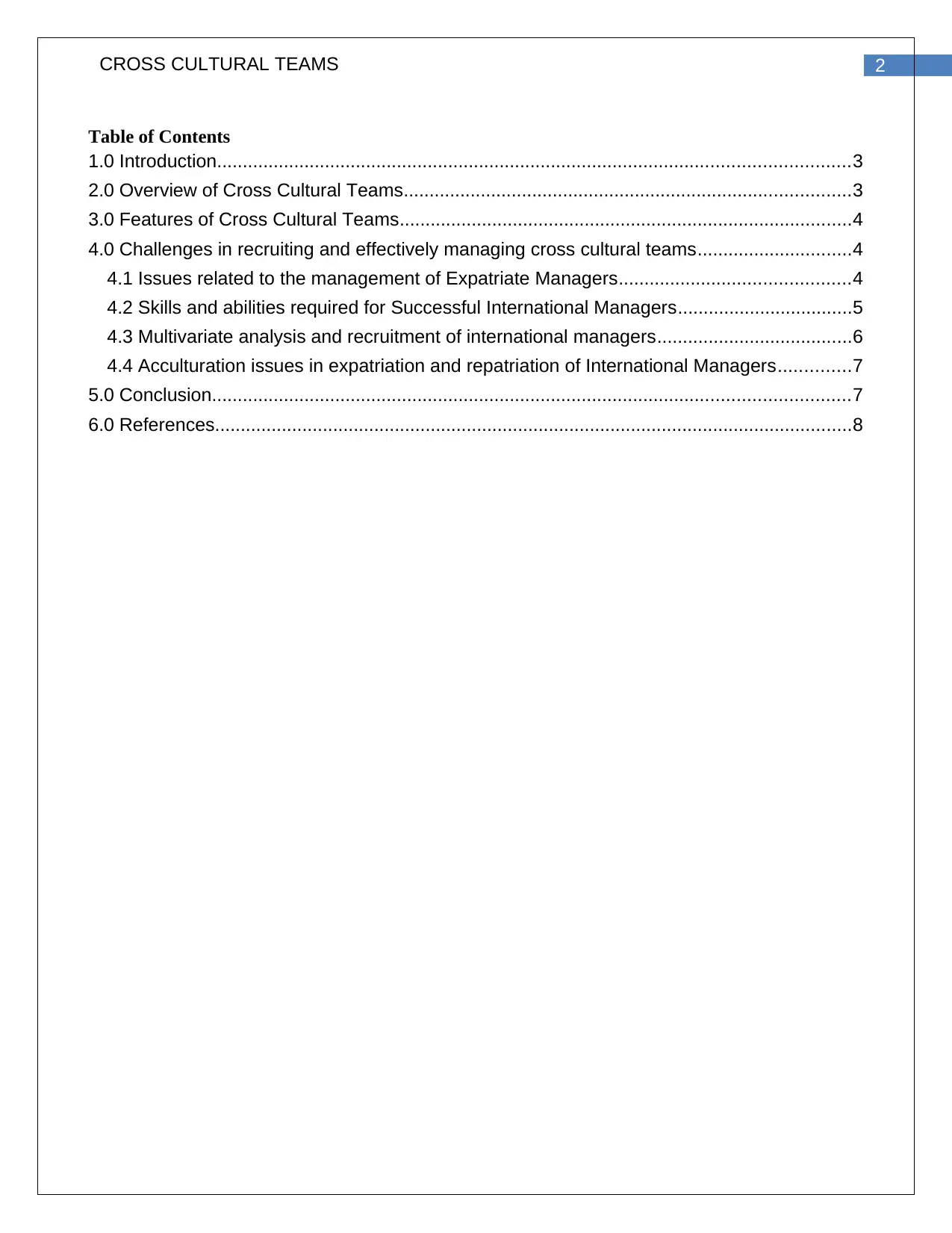
2CROSS CULTURAL TEAMS
Table of Contents
1.0 Introduction...........................................................................................................................3
2.0 Overview of Cross Cultural Teams.......................................................................................3
3.0 Features of Cross Cultural Teams........................................................................................4
4.0 Challenges in recruiting and effectively managing cross cultural teams..............................4
4.1 Issues related to the management of Expatriate Managers.............................................4
4.2 Skills and abilities required for Successful International Managers..................................5
4.3 Multivariate analysis and recruitment of international managers......................................6
4.4 Acculturation issues in expatriation and repatriation of International Managers..............7
5.0 Conclusion............................................................................................................................7
6.0 References............................................................................................................................8
Table of Contents
1.0 Introduction...........................................................................................................................3
2.0 Overview of Cross Cultural Teams.......................................................................................3
3.0 Features of Cross Cultural Teams........................................................................................4
4.0 Challenges in recruiting and effectively managing cross cultural teams..............................4
4.1 Issues related to the management of Expatriate Managers.............................................4
4.2 Skills and abilities required for Successful International Managers..................................5
4.3 Multivariate analysis and recruitment of international managers......................................6
4.4 Acculturation issues in expatriation and repatriation of International Managers..............7
5.0 Conclusion............................................................................................................................7
6.0 References............................................................................................................................8
⊘ This is a preview!⊘
Do you want full access?
Subscribe today to unlock all pages.

Trusted by 1+ million students worldwide
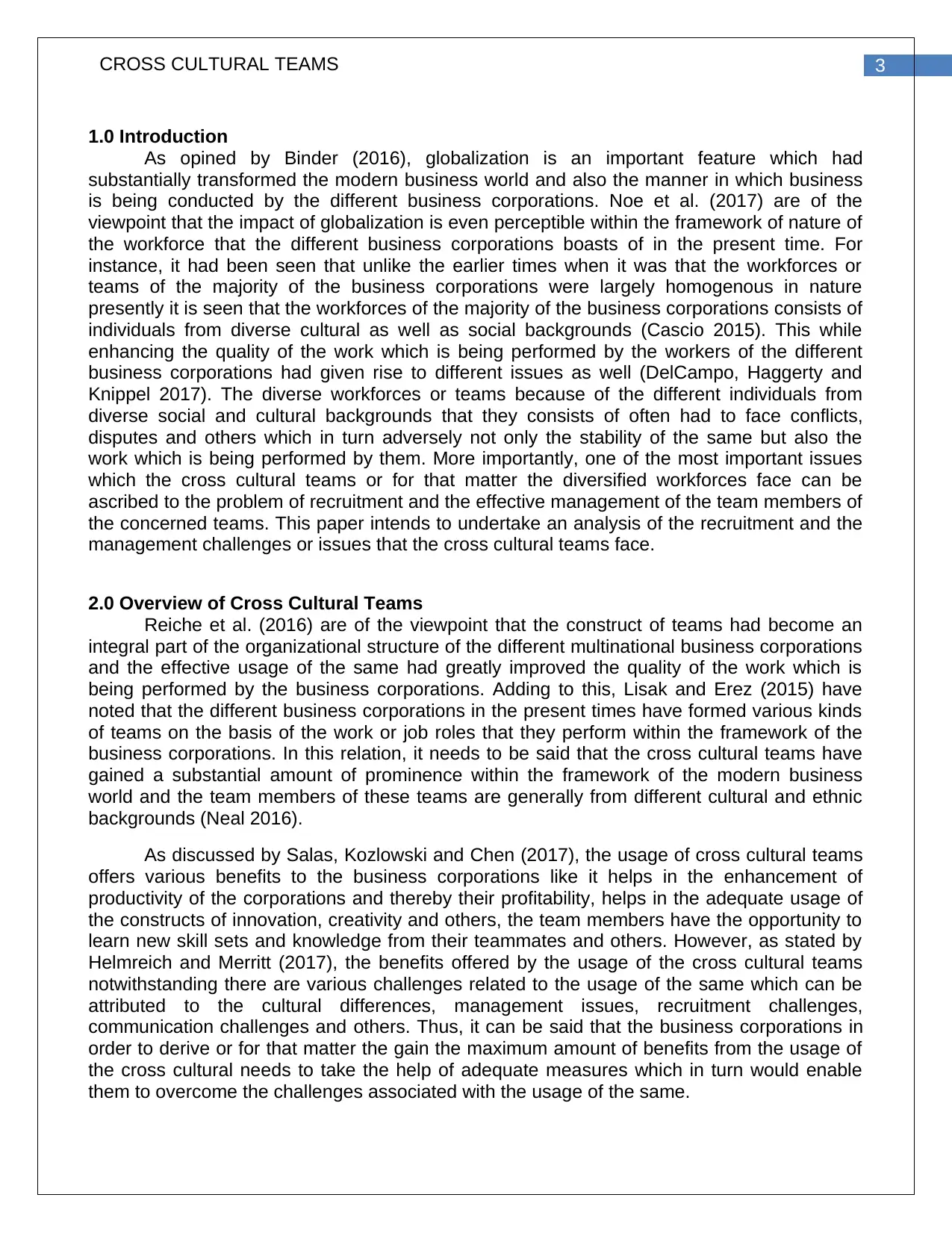
3CROSS CULTURAL TEAMS
1.0 Introduction
As opined by Binder (2016), globalization is an important feature which had
substantially transformed the modern business world and also the manner in which business
is being conducted by the different business corporations. Noe et al. (2017) are of the
viewpoint that the impact of globalization is even perceptible within the framework of nature of
the workforce that the different business corporations boasts of in the present time. For
instance, it had been seen that unlike the earlier times when it was that the workforces or
teams of the majority of the business corporations were largely homogenous in nature
presently it is seen that the workforces of the majority of the business corporations consists of
individuals from diverse cultural as well as social backgrounds (Cascio 2015). This while
enhancing the quality of the work which is being performed by the workers of the different
business corporations had given rise to different issues as well (DelCampo, Haggerty and
Knippel 2017). The diverse workforces or teams because of the different individuals from
diverse social and cultural backgrounds that they consists of often had to face conflicts,
disputes and others which in turn adversely not only the stability of the same but also the
work which is being performed by them. More importantly, one of the most important issues
which the cross cultural teams or for that matter the diversified workforces face can be
ascribed to the problem of recruitment and the effective management of the team members of
the concerned teams. This paper intends to undertake an analysis of the recruitment and the
management challenges or issues that the cross cultural teams face.
2.0 Overview of Cross Cultural Teams
Reiche et al. (2016) are of the viewpoint that the construct of teams had become an
integral part of the organizational structure of the different multinational business corporations
and the effective usage of the same had greatly improved the quality of the work which is
being performed by the business corporations. Adding to this, Lisak and Erez (2015) have
noted that the different business corporations in the present times have formed various kinds
of teams on the basis of the work or job roles that they perform within the framework of the
business corporations. In this relation, it needs to be said that the cross cultural teams have
gained a substantial amount of prominence within the framework of the modern business
world and the team members of these teams are generally from different cultural and ethnic
backgrounds (Neal 2016).
As discussed by Salas, Kozlowski and Chen (2017), the usage of cross cultural teams
offers various benefits to the business corporations like it helps in the enhancement of
productivity of the corporations and thereby their profitability, helps in the adequate usage of
the constructs of innovation, creativity and others, the team members have the opportunity to
learn new skill sets and knowledge from their teammates and others. However, as stated by
Helmreich and Merritt (2017), the benefits offered by the usage of the cross cultural teams
notwithstanding there are various challenges related to the usage of the same which can be
attributed to the cultural differences, management issues, recruitment challenges,
communication challenges and others. Thus, it can be said that the business corporations in
order to derive or for that matter the gain the maximum amount of benefits from the usage of
the cross cultural needs to take the help of adequate measures which in turn would enable
them to overcome the challenges associated with the usage of the same.
1.0 Introduction
As opined by Binder (2016), globalization is an important feature which had
substantially transformed the modern business world and also the manner in which business
is being conducted by the different business corporations. Noe et al. (2017) are of the
viewpoint that the impact of globalization is even perceptible within the framework of nature of
the workforce that the different business corporations boasts of in the present time. For
instance, it had been seen that unlike the earlier times when it was that the workforces or
teams of the majority of the business corporations were largely homogenous in nature
presently it is seen that the workforces of the majority of the business corporations consists of
individuals from diverse cultural as well as social backgrounds (Cascio 2015). This while
enhancing the quality of the work which is being performed by the workers of the different
business corporations had given rise to different issues as well (DelCampo, Haggerty and
Knippel 2017). The diverse workforces or teams because of the different individuals from
diverse social and cultural backgrounds that they consists of often had to face conflicts,
disputes and others which in turn adversely not only the stability of the same but also the
work which is being performed by them. More importantly, one of the most important issues
which the cross cultural teams or for that matter the diversified workforces face can be
ascribed to the problem of recruitment and the effective management of the team members of
the concerned teams. This paper intends to undertake an analysis of the recruitment and the
management challenges or issues that the cross cultural teams face.
2.0 Overview of Cross Cultural Teams
Reiche et al. (2016) are of the viewpoint that the construct of teams had become an
integral part of the organizational structure of the different multinational business corporations
and the effective usage of the same had greatly improved the quality of the work which is
being performed by the business corporations. Adding to this, Lisak and Erez (2015) have
noted that the different business corporations in the present times have formed various kinds
of teams on the basis of the work or job roles that they perform within the framework of the
business corporations. In this relation, it needs to be said that the cross cultural teams have
gained a substantial amount of prominence within the framework of the modern business
world and the team members of these teams are generally from different cultural and ethnic
backgrounds (Neal 2016).
As discussed by Salas, Kozlowski and Chen (2017), the usage of cross cultural teams
offers various benefits to the business corporations like it helps in the enhancement of
productivity of the corporations and thereby their profitability, helps in the adequate usage of
the constructs of innovation, creativity and others, the team members have the opportunity to
learn new skill sets and knowledge from their teammates and others. However, as stated by
Helmreich and Merritt (2017), the benefits offered by the usage of the cross cultural teams
notwithstanding there are various challenges related to the usage of the same which can be
attributed to the cultural differences, management issues, recruitment challenges,
communication challenges and others. Thus, it can be said that the business corporations in
order to derive or for that matter the gain the maximum amount of benefits from the usage of
the cross cultural needs to take the help of adequate measures which in turn would enable
them to overcome the challenges associated with the usage of the same.
Paraphrase This Document
Need a fresh take? Get an instant paraphrase of this document with our AI Paraphraser
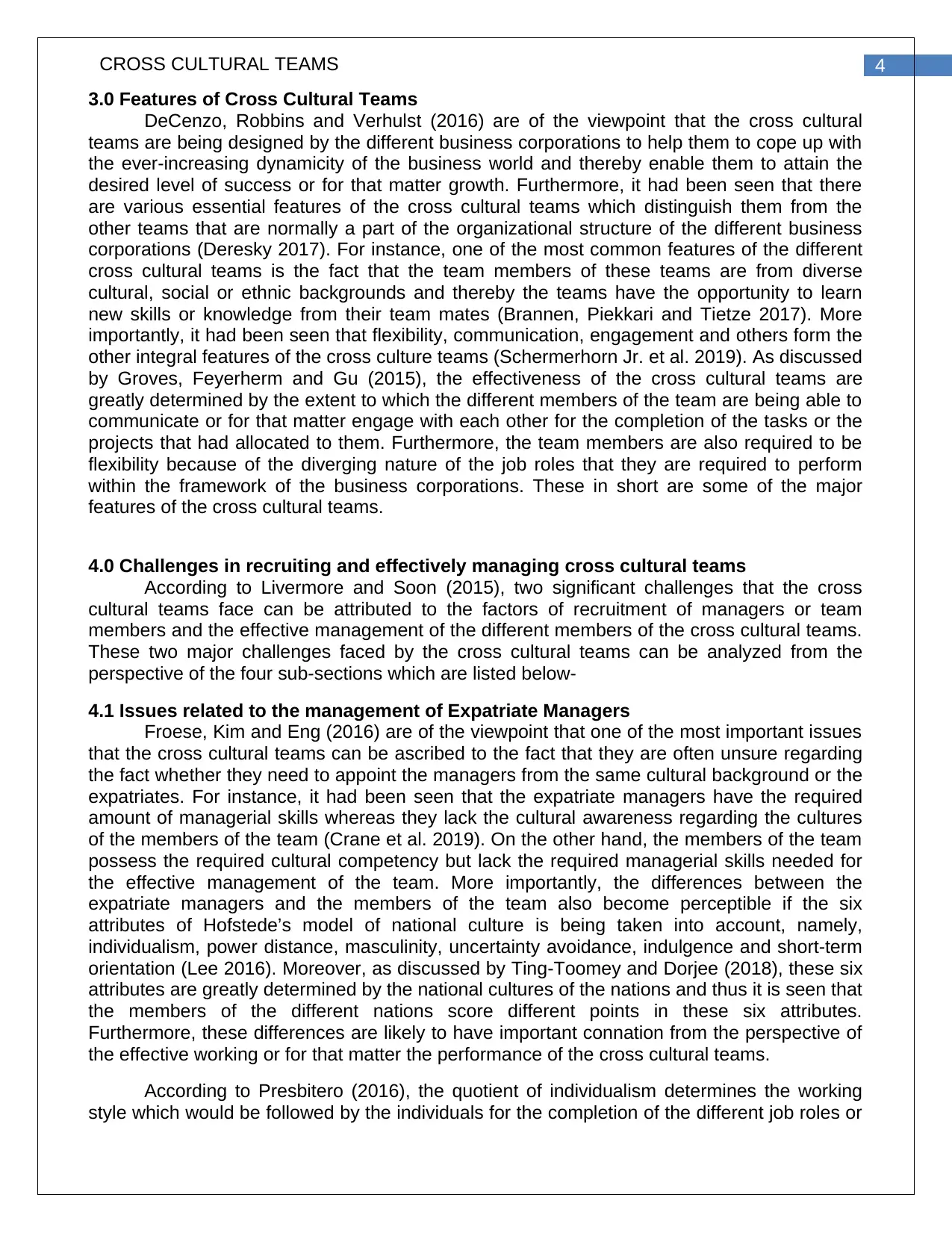
4CROSS CULTURAL TEAMS
3.0 Features of Cross Cultural Teams
DeCenzo, Robbins and Verhulst (2016) are of the viewpoint that the cross cultural
teams are being designed by the different business corporations to help them to cope up with
the ever-increasing dynamicity of the business world and thereby enable them to attain the
desired level of success or for that matter growth. Furthermore, it had been seen that there
are various essential features of the cross cultural teams which distinguish them from the
other teams that are normally a part of the organizational structure of the different business
corporations (Deresky 2017). For instance, one of the most common features of the different
cross cultural teams is the fact that the team members of these teams are from diverse
cultural, social or ethnic backgrounds and thereby the teams have the opportunity to learn
new skills or knowledge from their team mates (Brannen, Piekkari and Tietze 2017). More
importantly, it had been seen that flexibility, communication, engagement and others form the
other integral features of the cross culture teams (Schermerhorn Jr. et al. 2019). As discussed
by Groves, Feyerherm and Gu (2015), the effectiveness of the cross cultural teams are
greatly determined by the extent to which the different members of the team are being able to
communicate or for that matter engage with each other for the completion of the tasks or the
projects that had allocated to them. Furthermore, the team members are also required to be
flexibility because of the diverging nature of the job roles that they are required to perform
within the framework of the business corporations. These in short are some of the major
features of the cross cultural teams.
4.0 Challenges in recruiting and effectively managing cross cultural teams
According to Livermore and Soon (2015), two significant challenges that the cross
cultural teams face can be attributed to the factors of recruitment of managers or team
members and the effective management of the different members of the cross cultural teams.
These two major challenges faced by the cross cultural teams can be analyzed from the
perspective of the four sub-sections which are listed below-
4.1 Issues related to the management of Expatriate Managers
Froese, Kim and Eng (2016) are of the viewpoint that one of the most important issues
that the cross cultural teams can be ascribed to the fact that they are often unsure regarding
the fact whether they need to appoint the managers from the same cultural background or the
expatriates. For instance, it had been seen that the expatriate managers have the required
amount of managerial skills whereas they lack the cultural awareness regarding the cultures
of the members of the team (Crane et al. 2019). On the other hand, the members of the team
possess the required cultural competency but lack the required managerial skills needed for
the effective management of the team. More importantly, the differences between the
expatriate managers and the members of the team also become perceptible if the six
attributes of Hofstede’s model of national culture is being taken into account, namely,
individualism, power distance, masculinity, uncertainty avoidance, indulgence and short-term
orientation (Lee 2016). Moreover, as discussed by Ting-Toomey and Dorjee (2018), these six
attributes are greatly determined by the national cultures of the nations and thus it is seen that
the members of the different nations score different points in these six attributes.
Furthermore, these differences are likely to have important connation from the perspective of
the effective working or for that matter the performance of the cross cultural teams.
According to Presbitero (2016), the quotient of individualism determines the working
style which would be followed by the individuals for the completion of the different job roles or
3.0 Features of Cross Cultural Teams
DeCenzo, Robbins and Verhulst (2016) are of the viewpoint that the cross cultural
teams are being designed by the different business corporations to help them to cope up with
the ever-increasing dynamicity of the business world and thereby enable them to attain the
desired level of success or for that matter growth. Furthermore, it had been seen that there
are various essential features of the cross cultural teams which distinguish them from the
other teams that are normally a part of the organizational structure of the different business
corporations (Deresky 2017). For instance, one of the most common features of the different
cross cultural teams is the fact that the team members of these teams are from diverse
cultural, social or ethnic backgrounds and thereby the teams have the opportunity to learn
new skills or knowledge from their team mates (Brannen, Piekkari and Tietze 2017). More
importantly, it had been seen that flexibility, communication, engagement and others form the
other integral features of the cross culture teams (Schermerhorn Jr. et al. 2019). As discussed
by Groves, Feyerherm and Gu (2015), the effectiveness of the cross cultural teams are
greatly determined by the extent to which the different members of the team are being able to
communicate or for that matter engage with each other for the completion of the tasks or the
projects that had allocated to them. Furthermore, the team members are also required to be
flexibility because of the diverging nature of the job roles that they are required to perform
within the framework of the business corporations. These in short are some of the major
features of the cross cultural teams.
4.0 Challenges in recruiting and effectively managing cross cultural teams
According to Livermore and Soon (2015), two significant challenges that the cross
cultural teams face can be attributed to the factors of recruitment of managers or team
members and the effective management of the different members of the cross cultural teams.
These two major challenges faced by the cross cultural teams can be analyzed from the
perspective of the four sub-sections which are listed below-
4.1 Issues related to the management of Expatriate Managers
Froese, Kim and Eng (2016) are of the viewpoint that one of the most important issues
that the cross cultural teams can be ascribed to the fact that they are often unsure regarding
the fact whether they need to appoint the managers from the same cultural background or the
expatriates. For instance, it had been seen that the expatriate managers have the required
amount of managerial skills whereas they lack the cultural awareness regarding the cultures
of the members of the team (Crane et al. 2019). On the other hand, the members of the team
possess the required cultural competency but lack the required managerial skills needed for
the effective management of the team. More importantly, the differences between the
expatriate managers and the members of the team also become perceptible if the six
attributes of Hofstede’s model of national culture is being taken into account, namely,
individualism, power distance, masculinity, uncertainty avoidance, indulgence and short-term
orientation (Lee 2016). Moreover, as discussed by Ting-Toomey and Dorjee (2018), these six
attributes are greatly determined by the national cultures of the nations and thus it is seen that
the members of the different nations score different points in these six attributes.
Furthermore, these differences are likely to have important connation from the perspective of
the effective working or for that matter the performance of the cross cultural teams.
According to Presbitero (2016), the quotient of individualism determines the working
style which would be followed by the individuals for the completion of the different job roles or
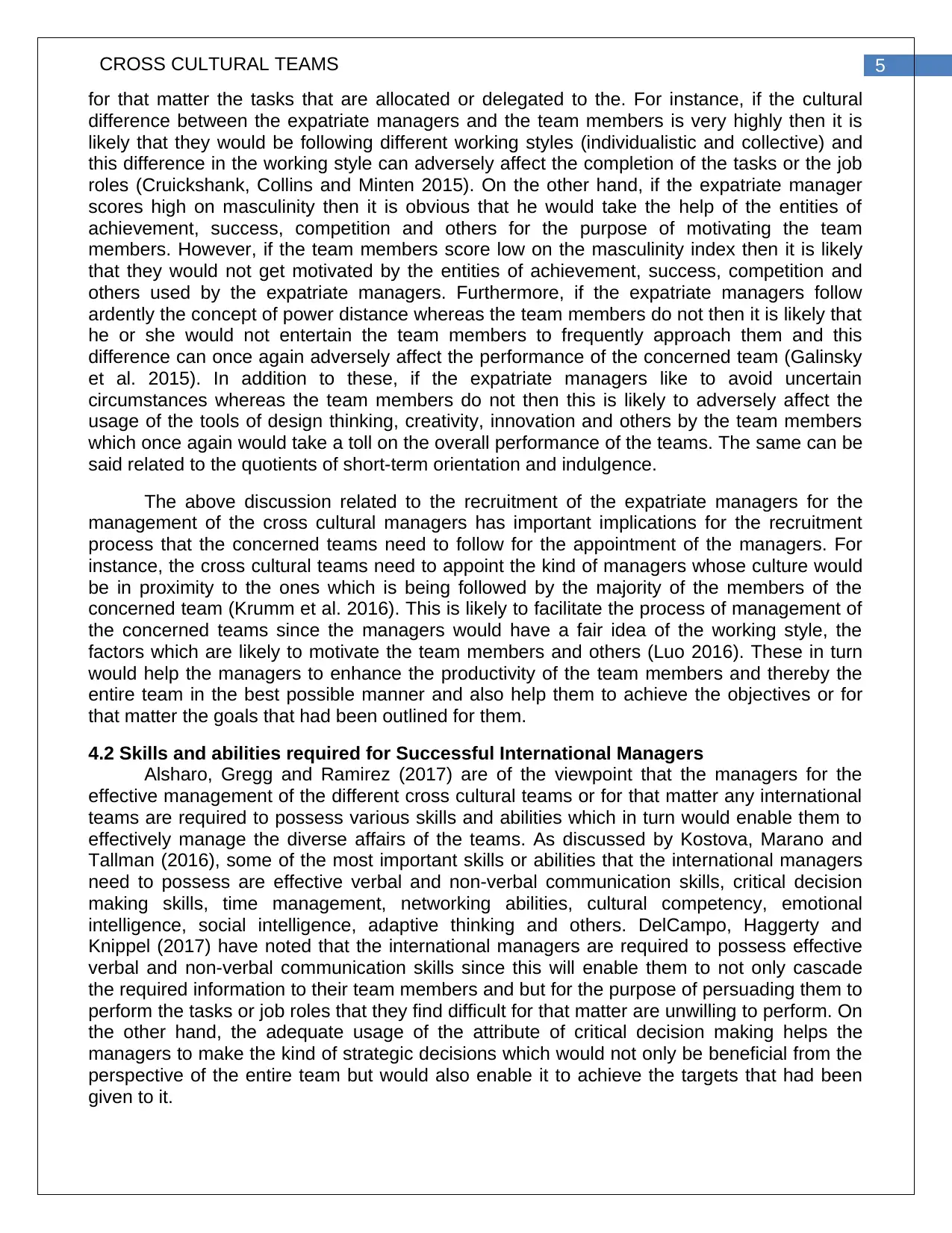
5CROSS CULTURAL TEAMS
for that matter the tasks that are allocated or delegated to the. For instance, if the cultural
difference between the expatriate managers and the team members is very highly then it is
likely that they would be following different working styles (individualistic and collective) and
this difference in the working style can adversely affect the completion of the tasks or the job
roles (Cruickshank, Collins and Minten 2015). On the other hand, if the expatriate manager
scores high on masculinity then it is obvious that he would take the help of the entities of
achievement, success, competition and others for the purpose of motivating the team
members. However, if the team members score low on the masculinity index then it is likely
that they would not get motivated by the entities of achievement, success, competition and
others used by the expatriate managers. Furthermore, if the expatriate managers follow
ardently the concept of power distance whereas the team members do not then it is likely that
he or she would not entertain the team members to frequently approach them and this
difference can once again adversely affect the performance of the concerned team (Galinsky
et al. 2015). In addition to these, if the expatriate managers like to avoid uncertain
circumstances whereas the team members do not then this is likely to adversely affect the
usage of the tools of design thinking, creativity, innovation and others by the team members
which once again would take a toll on the overall performance of the teams. The same can be
said related to the quotients of short-term orientation and indulgence.
The above discussion related to the recruitment of the expatriate managers for the
management of the cross cultural managers has important implications for the recruitment
process that the concerned teams need to follow for the appointment of the managers. For
instance, the cross cultural teams need to appoint the kind of managers whose culture would
be in proximity to the ones which is being followed by the majority of the members of the
concerned team (Krumm et al. 2016). This is likely to facilitate the process of management of
the concerned teams since the managers would have a fair idea of the working style, the
factors which are likely to motivate the team members and others (Luo 2016). These in turn
would help the managers to enhance the productivity of the team members and thereby the
entire team in the best possible manner and also help them to achieve the objectives or for
that matter the goals that had been outlined for them.
4.2 Skills and abilities required for Successful International Managers
Alsharo, Gregg and Ramirez (2017) are of the viewpoint that the managers for the
effective management of the different cross cultural teams or for that matter any international
teams are required to possess various skills and abilities which in turn would enable them to
effectively manage the diverse affairs of the teams. As discussed by Kostova, Marano and
Tallman (2016), some of the most important skills or abilities that the international managers
need to possess are effective verbal and non-verbal communication skills, critical decision
making skills, time management, networking abilities, cultural competency, emotional
intelligence, social intelligence, adaptive thinking and others. DelCampo, Haggerty and
Knippel (2017) have noted that the international managers are required to possess effective
verbal and non-verbal communication skills since this will enable them to not only cascade
the required information to their team members and but for the purpose of persuading them to
perform the tasks or job roles that they find difficult for that matter are unwilling to perform. On
the other hand, the adequate usage of the attribute of critical decision making helps the
managers to make the kind of strategic decisions which would not only be beneficial from the
perspective of the entire team but would also enable it to achieve the targets that had been
given to it.
for that matter the tasks that are allocated or delegated to the. For instance, if the cultural
difference between the expatriate managers and the team members is very highly then it is
likely that they would be following different working styles (individualistic and collective) and
this difference in the working style can adversely affect the completion of the tasks or the job
roles (Cruickshank, Collins and Minten 2015). On the other hand, if the expatriate manager
scores high on masculinity then it is obvious that he would take the help of the entities of
achievement, success, competition and others for the purpose of motivating the team
members. However, if the team members score low on the masculinity index then it is likely
that they would not get motivated by the entities of achievement, success, competition and
others used by the expatriate managers. Furthermore, if the expatriate managers follow
ardently the concept of power distance whereas the team members do not then it is likely that
he or she would not entertain the team members to frequently approach them and this
difference can once again adversely affect the performance of the concerned team (Galinsky
et al. 2015). In addition to these, if the expatriate managers like to avoid uncertain
circumstances whereas the team members do not then this is likely to adversely affect the
usage of the tools of design thinking, creativity, innovation and others by the team members
which once again would take a toll on the overall performance of the teams. The same can be
said related to the quotients of short-term orientation and indulgence.
The above discussion related to the recruitment of the expatriate managers for the
management of the cross cultural managers has important implications for the recruitment
process that the concerned teams need to follow for the appointment of the managers. For
instance, the cross cultural teams need to appoint the kind of managers whose culture would
be in proximity to the ones which is being followed by the majority of the members of the
concerned team (Krumm et al. 2016). This is likely to facilitate the process of management of
the concerned teams since the managers would have a fair idea of the working style, the
factors which are likely to motivate the team members and others (Luo 2016). These in turn
would help the managers to enhance the productivity of the team members and thereby the
entire team in the best possible manner and also help them to achieve the objectives or for
that matter the goals that had been outlined for them.
4.2 Skills and abilities required for Successful International Managers
Alsharo, Gregg and Ramirez (2017) are of the viewpoint that the managers for the
effective management of the different cross cultural teams or for that matter any international
teams are required to possess various skills and abilities which in turn would enable them to
effectively manage the diverse affairs of the teams. As discussed by Kostova, Marano and
Tallman (2016), some of the most important skills or abilities that the international managers
need to possess are effective verbal and non-verbal communication skills, critical decision
making skills, time management, networking abilities, cultural competency, emotional
intelligence, social intelligence, adaptive thinking and others. DelCampo, Haggerty and
Knippel (2017) have noted that the international managers are required to possess effective
verbal and non-verbal communication skills since this will enable them to not only cascade
the required information to their team members and but for the purpose of persuading them to
perform the tasks or job roles that they find difficult for that matter are unwilling to perform. On
the other hand, the adequate usage of the attribute of critical decision making helps the
managers to make the kind of strategic decisions which would not only be beneficial from the
perspective of the entire team but would also enable it to achieve the targets that had been
given to it.
⊘ This is a preview!⊘
Do you want full access?
Subscribe today to unlock all pages.

Trusted by 1+ million students worldwide
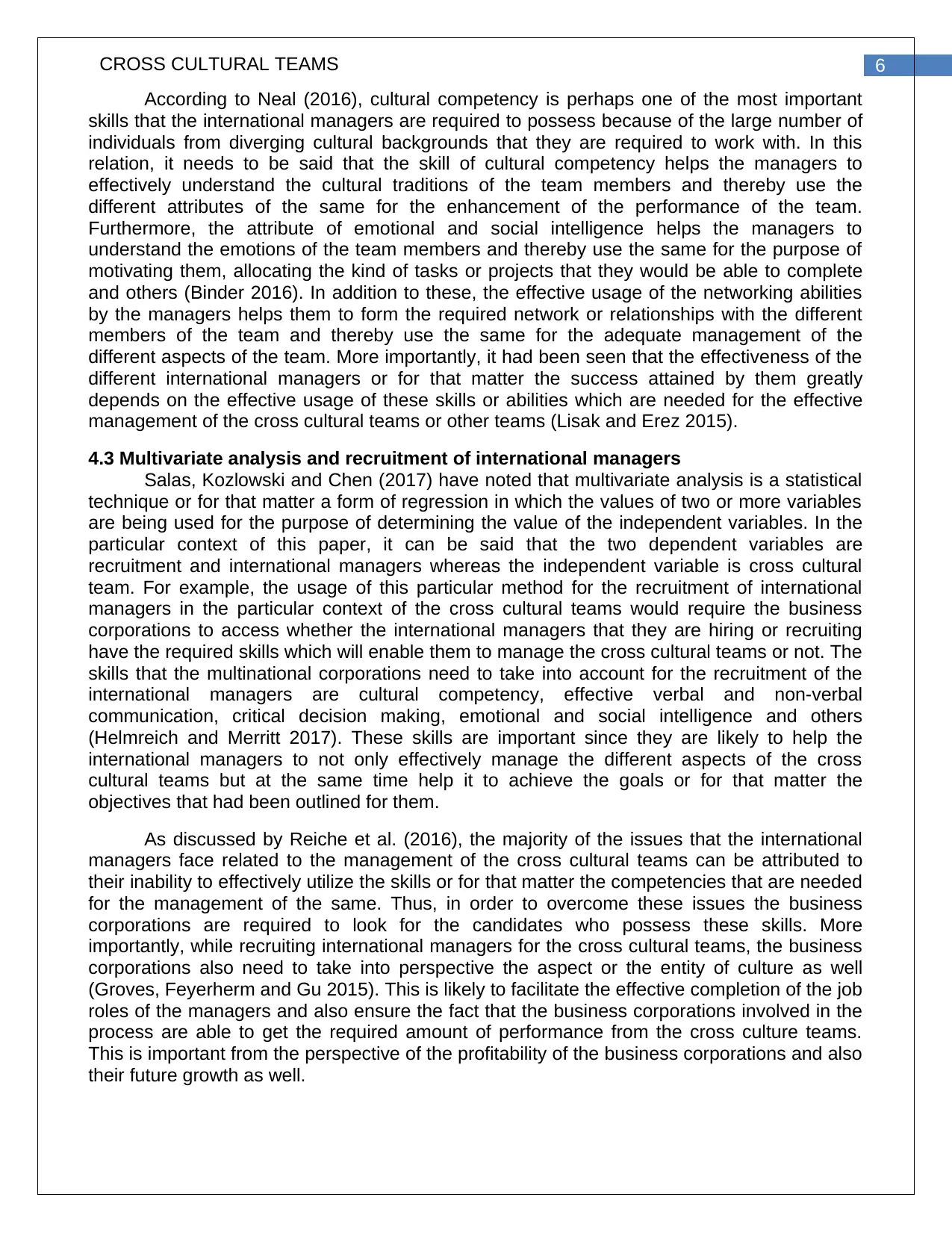
6CROSS CULTURAL TEAMS
According to Neal (2016), cultural competency is perhaps one of the most important
skills that the international managers are required to possess because of the large number of
individuals from diverging cultural backgrounds that they are required to work with. In this
relation, it needs to be said that the skill of cultural competency helps the managers to
effectively understand the cultural traditions of the team members and thereby use the
different attributes of the same for the enhancement of the performance of the team.
Furthermore, the attribute of emotional and social intelligence helps the managers to
understand the emotions of the team members and thereby use the same for the purpose of
motivating them, allocating the kind of tasks or projects that they would be able to complete
and others (Binder 2016). In addition to these, the effective usage of the networking abilities
by the managers helps them to form the required network or relationships with the different
members of the team and thereby use the same for the adequate management of the
different aspects of the team. More importantly, it had been seen that the effectiveness of the
different international managers or for that matter the success attained by them greatly
depends on the effective usage of these skills or abilities which are needed for the effective
management of the cross cultural teams or other teams (Lisak and Erez 2015).
4.3 Multivariate analysis and recruitment of international managers
Salas, Kozlowski and Chen (2017) have noted that multivariate analysis is a statistical
technique or for that matter a form of regression in which the values of two or more variables
are being used for the purpose of determining the value of the independent variables. In the
particular context of this paper, it can be said that the two dependent variables are
recruitment and international managers whereas the independent variable is cross cultural
team. For example, the usage of this particular method for the recruitment of international
managers in the particular context of the cross cultural teams would require the business
corporations to access whether the international managers that they are hiring or recruiting
have the required skills which will enable them to manage the cross cultural teams or not. The
skills that the multinational corporations need to take into account for the recruitment of the
international managers are cultural competency, effective verbal and non-verbal
communication, critical decision making, emotional and social intelligence and others
(Helmreich and Merritt 2017). These skills are important since they are likely to help the
international managers to not only effectively manage the different aspects of the cross
cultural teams but at the same time help it to achieve the goals or for that matter the
objectives that had been outlined for them.
As discussed by Reiche et al. (2016), the majority of the issues that the international
managers face related to the management of the cross cultural teams can be attributed to
their inability to effectively utilize the skills or for that matter the competencies that are needed
for the management of the same. Thus, in order to overcome these issues the business
corporations are required to look for the candidates who possess these skills. More
importantly, while recruiting international managers for the cross cultural teams, the business
corporations also need to take into perspective the aspect or the entity of culture as well
(Groves, Feyerherm and Gu 2015). This is likely to facilitate the effective completion of the job
roles of the managers and also ensure the fact that the business corporations involved in the
process are able to get the required amount of performance from the cross culture teams.
This is important from the perspective of the profitability of the business corporations and also
their future growth as well.
According to Neal (2016), cultural competency is perhaps one of the most important
skills that the international managers are required to possess because of the large number of
individuals from diverging cultural backgrounds that they are required to work with. In this
relation, it needs to be said that the skill of cultural competency helps the managers to
effectively understand the cultural traditions of the team members and thereby use the
different attributes of the same for the enhancement of the performance of the team.
Furthermore, the attribute of emotional and social intelligence helps the managers to
understand the emotions of the team members and thereby use the same for the purpose of
motivating them, allocating the kind of tasks or projects that they would be able to complete
and others (Binder 2016). In addition to these, the effective usage of the networking abilities
by the managers helps them to form the required network or relationships with the different
members of the team and thereby use the same for the adequate management of the
different aspects of the team. More importantly, it had been seen that the effectiveness of the
different international managers or for that matter the success attained by them greatly
depends on the effective usage of these skills or abilities which are needed for the effective
management of the cross cultural teams or other teams (Lisak and Erez 2015).
4.3 Multivariate analysis and recruitment of international managers
Salas, Kozlowski and Chen (2017) have noted that multivariate analysis is a statistical
technique or for that matter a form of regression in which the values of two or more variables
are being used for the purpose of determining the value of the independent variables. In the
particular context of this paper, it can be said that the two dependent variables are
recruitment and international managers whereas the independent variable is cross cultural
team. For example, the usage of this particular method for the recruitment of international
managers in the particular context of the cross cultural teams would require the business
corporations to access whether the international managers that they are hiring or recruiting
have the required skills which will enable them to manage the cross cultural teams or not. The
skills that the multinational corporations need to take into account for the recruitment of the
international managers are cultural competency, effective verbal and non-verbal
communication, critical decision making, emotional and social intelligence and others
(Helmreich and Merritt 2017). These skills are important since they are likely to help the
international managers to not only effectively manage the different aspects of the cross
cultural teams but at the same time help it to achieve the goals or for that matter the
objectives that had been outlined for them.
As discussed by Reiche et al. (2016), the majority of the issues that the international
managers face related to the management of the cross cultural teams can be attributed to
their inability to effectively utilize the skills or for that matter the competencies that are needed
for the management of the same. Thus, in order to overcome these issues the business
corporations are required to look for the candidates who possess these skills. More
importantly, while recruiting international managers for the cross cultural teams, the business
corporations also need to take into perspective the aspect or the entity of culture as well
(Groves, Feyerherm and Gu 2015). This is likely to facilitate the effective completion of the job
roles of the managers and also ensure the fact that the business corporations involved in the
process are able to get the required amount of performance from the cross culture teams.
This is important from the perspective of the profitability of the business corporations and also
their future growth as well.
Paraphrase This Document
Need a fresh take? Get an instant paraphrase of this document with our AI Paraphraser
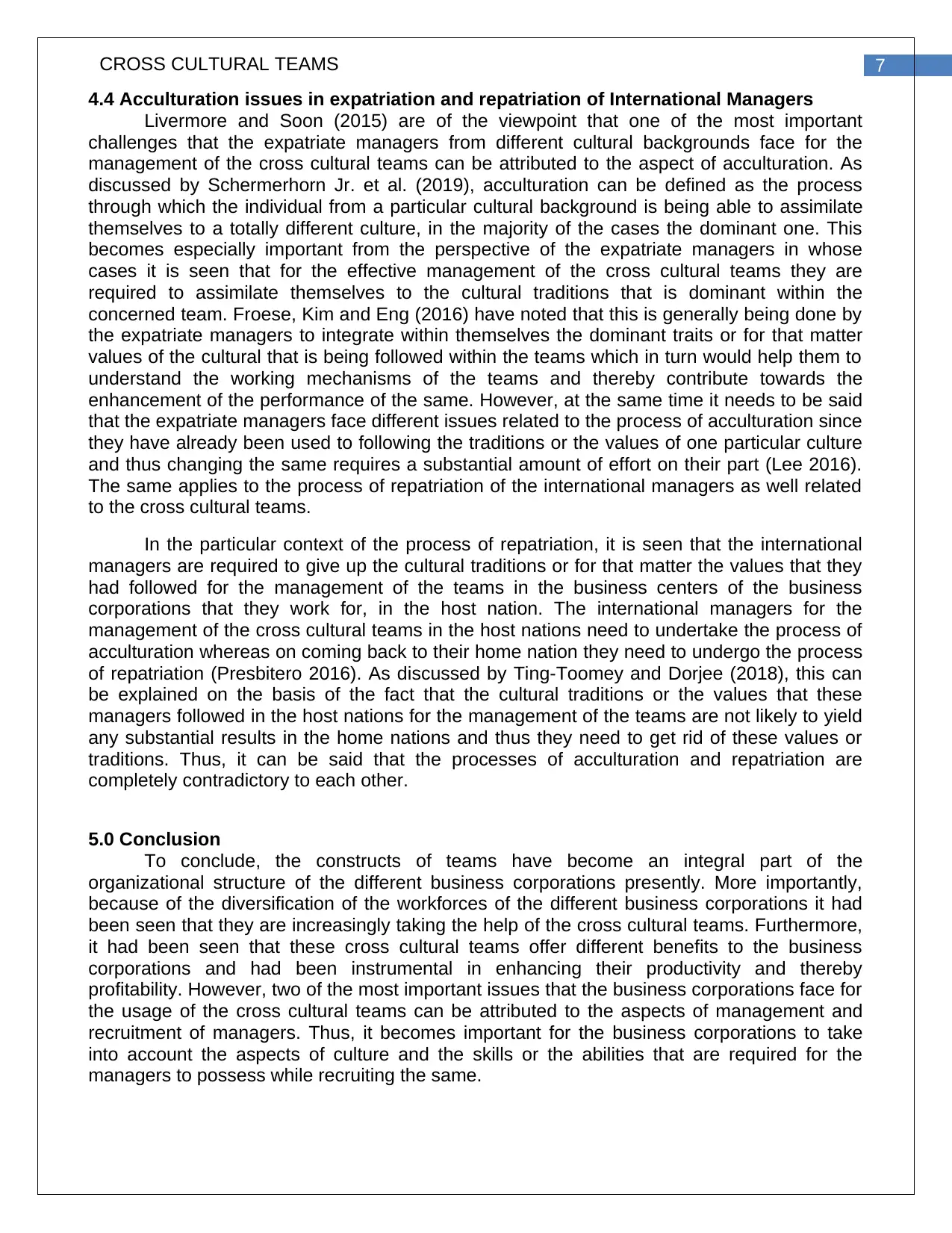
7CROSS CULTURAL TEAMS
4.4 Acculturation issues in expatriation and repatriation of International Managers
Livermore and Soon (2015) are of the viewpoint that one of the most important
challenges that the expatriate managers from different cultural backgrounds face for the
management of the cross cultural teams can be attributed to the aspect of acculturation. As
discussed by Schermerhorn Jr. et al. (2019), acculturation can be defined as the process
through which the individual from a particular cultural background is being able to assimilate
themselves to a totally different culture, in the majority of the cases the dominant one. This
becomes especially important from the perspective of the expatriate managers in whose
cases it is seen that for the effective management of the cross cultural teams they are
required to assimilate themselves to the cultural traditions that is dominant within the
concerned team. Froese, Kim and Eng (2016) have noted that this is generally being done by
the expatriate managers to integrate within themselves the dominant traits or for that matter
values of the cultural that is being followed within the teams which in turn would help them to
understand the working mechanisms of the teams and thereby contribute towards the
enhancement of the performance of the same. However, at the same time it needs to be said
that the expatriate managers face different issues related to the process of acculturation since
they have already been used to following the traditions or the values of one particular culture
and thus changing the same requires a substantial amount of effort on their part (Lee 2016).
The same applies to the process of repatriation of the international managers as well related
to the cross cultural teams.
In the particular context of the process of repatriation, it is seen that the international
managers are required to give up the cultural traditions or for that matter the values that they
had followed for the management of the teams in the business centers of the business
corporations that they work for, in the host nation. The international managers for the
management of the cross cultural teams in the host nations need to undertake the process of
acculturation whereas on coming back to their home nation they need to undergo the process
of repatriation (Presbitero 2016). As discussed by Ting-Toomey and Dorjee (2018), this can
be explained on the basis of the fact that the cultural traditions or the values that these
managers followed in the host nations for the management of the teams are not likely to yield
any substantial results in the home nations and thus they need to get rid of these values or
traditions. Thus, it can be said that the processes of acculturation and repatriation are
completely contradictory to each other.
5.0 Conclusion
To conclude, the constructs of teams have become an integral part of the
organizational structure of the different business corporations presently. More importantly,
because of the diversification of the workforces of the different business corporations it had
been seen that they are increasingly taking the help of the cross cultural teams. Furthermore,
it had been seen that these cross cultural teams offer different benefits to the business
corporations and had been instrumental in enhancing their productivity and thereby
profitability. However, two of the most important issues that the business corporations face for
the usage of the cross cultural teams can be attributed to the aspects of management and
recruitment of managers. Thus, it becomes important for the business corporations to take
into account the aspects of culture and the skills or the abilities that are required for the
managers to possess while recruiting the same.
4.4 Acculturation issues in expatriation and repatriation of International Managers
Livermore and Soon (2015) are of the viewpoint that one of the most important
challenges that the expatriate managers from different cultural backgrounds face for the
management of the cross cultural teams can be attributed to the aspect of acculturation. As
discussed by Schermerhorn Jr. et al. (2019), acculturation can be defined as the process
through which the individual from a particular cultural background is being able to assimilate
themselves to a totally different culture, in the majority of the cases the dominant one. This
becomes especially important from the perspective of the expatriate managers in whose
cases it is seen that for the effective management of the cross cultural teams they are
required to assimilate themselves to the cultural traditions that is dominant within the
concerned team. Froese, Kim and Eng (2016) have noted that this is generally being done by
the expatriate managers to integrate within themselves the dominant traits or for that matter
values of the cultural that is being followed within the teams which in turn would help them to
understand the working mechanisms of the teams and thereby contribute towards the
enhancement of the performance of the same. However, at the same time it needs to be said
that the expatriate managers face different issues related to the process of acculturation since
they have already been used to following the traditions or the values of one particular culture
and thus changing the same requires a substantial amount of effort on their part (Lee 2016).
The same applies to the process of repatriation of the international managers as well related
to the cross cultural teams.
In the particular context of the process of repatriation, it is seen that the international
managers are required to give up the cultural traditions or for that matter the values that they
had followed for the management of the teams in the business centers of the business
corporations that they work for, in the host nation. The international managers for the
management of the cross cultural teams in the host nations need to undertake the process of
acculturation whereas on coming back to their home nation they need to undergo the process
of repatriation (Presbitero 2016). As discussed by Ting-Toomey and Dorjee (2018), this can
be explained on the basis of the fact that the cultural traditions or the values that these
managers followed in the host nations for the management of the teams are not likely to yield
any substantial results in the home nations and thus they need to get rid of these values or
traditions. Thus, it can be said that the processes of acculturation and repatriation are
completely contradictory to each other.
5.0 Conclusion
To conclude, the constructs of teams have become an integral part of the
organizational structure of the different business corporations presently. More importantly,
because of the diversification of the workforces of the different business corporations it had
been seen that they are increasingly taking the help of the cross cultural teams. Furthermore,
it had been seen that these cross cultural teams offer different benefits to the business
corporations and had been instrumental in enhancing their productivity and thereby
profitability. However, two of the most important issues that the business corporations face for
the usage of the cross cultural teams can be attributed to the aspects of management and
recruitment of managers. Thus, it becomes important for the business corporations to take
into account the aspects of culture and the skills or the abilities that are required for the
managers to possess while recruiting the same.
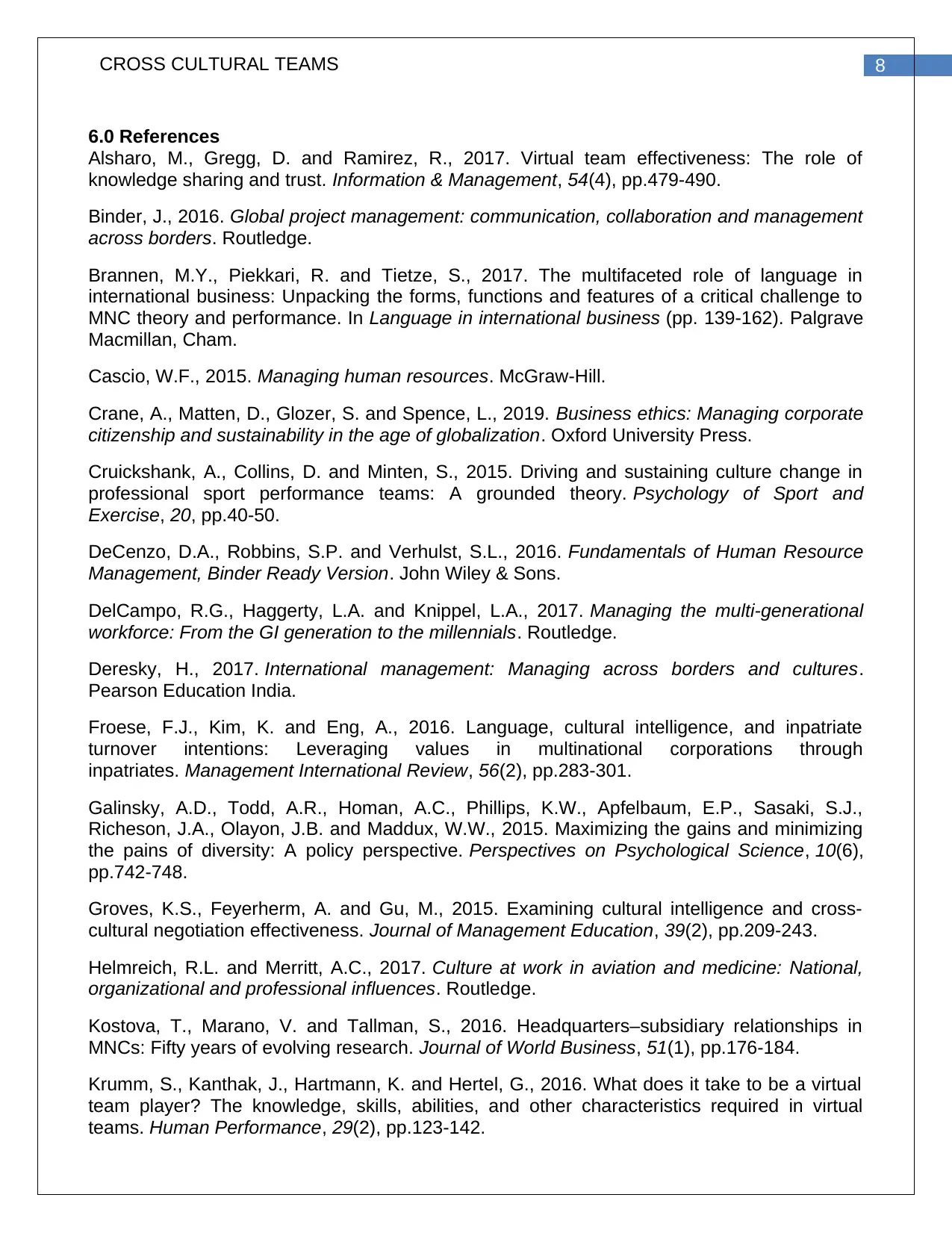
8CROSS CULTURAL TEAMS
6.0 References
Alsharo, M., Gregg, D. and Ramirez, R., 2017. Virtual team effectiveness: The role of
knowledge sharing and trust. Information & Management, 54(4), pp.479-490.
Binder, J., 2016. Global project management: communication, collaboration and management
across borders. Routledge.
Brannen, M.Y., Piekkari, R. and Tietze, S., 2017. The multifaceted role of language in
international business: Unpacking the forms, functions and features of a critical challenge to
MNC theory and performance. In Language in international business (pp. 139-162). Palgrave
Macmillan, Cham.
Cascio, W.F., 2015. Managing human resources. McGraw-Hill.
Crane, A., Matten, D., Glozer, S. and Spence, L., 2019. Business ethics: Managing corporate
citizenship and sustainability in the age of globalization. Oxford University Press.
Cruickshank, A., Collins, D. and Minten, S., 2015. Driving and sustaining culture change in
professional sport performance teams: A grounded theory. Psychology of Sport and
Exercise, 20, pp.40-50.
DeCenzo, D.A., Robbins, S.P. and Verhulst, S.L., 2016. Fundamentals of Human Resource
Management, Binder Ready Version. John Wiley & Sons.
DelCampo, R.G., Haggerty, L.A. and Knippel, L.A., 2017. Managing the multi-generational
workforce: From the GI generation to the millennials. Routledge.
Deresky, H., 2017. International management: Managing across borders and cultures.
Pearson Education India.
Froese, F.J., Kim, K. and Eng, A., 2016. Language, cultural intelligence, and inpatriate
turnover intentions: Leveraging values in multinational corporations through
inpatriates. Management International Review, 56(2), pp.283-301.
Galinsky, A.D., Todd, A.R., Homan, A.C., Phillips, K.W., Apfelbaum, E.P., Sasaki, S.J.,
Richeson, J.A., Olayon, J.B. and Maddux, W.W., 2015. Maximizing the gains and minimizing
the pains of diversity: A policy perspective. Perspectives on Psychological Science, 10(6),
pp.742-748.
Groves, K.S., Feyerherm, A. and Gu, M., 2015. Examining cultural intelligence and cross-
cultural negotiation effectiveness. Journal of Management Education, 39(2), pp.209-243.
Helmreich, R.L. and Merritt, A.C., 2017. Culture at work in aviation and medicine: National,
organizational and professional influences. Routledge.
Kostova, T., Marano, V. and Tallman, S., 2016. Headquarters–subsidiary relationships in
MNCs: Fifty years of evolving research. Journal of World Business, 51(1), pp.176-184.
Krumm, S., Kanthak, J., Hartmann, K. and Hertel, G., 2016. What does it take to be a virtual
team player? The knowledge, skills, abilities, and other characteristics required in virtual
teams. Human Performance, 29(2), pp.123-142.
6.0 References
Alsharo, M., Gregg, D. and Ramirez, R., 2017. Virtual team effectiveness: The role of
knowledge sharing and trust. Information & Management, 54(4), pp.479-490.
Binder, J., 2016. Global project management: communication, collaboration and management
across borders. Routledge.
Brannen, M.Y., Piekkari, R. and Tietze, S., 2017. The multifaceted role of language in
international business: Unpacking the forms, functions and features of a critical challenge to
MNC theory and performance. In Language in international business (pp. 139-162). Palgrave
Macmillan, Cham.
Cascio, W.F., 2015. Managing human resources. McGraw-Hill.
Crane, A., Matten, D., Glozer, S. and Spence, L., 2019. Business ethics: Managing corporate
citizenship and sustainability in the age of globalization. Oxford University Press.
Cruickshank, A., Collins, D. and Minten, S., 2015. Driving and sustaining culture change in
professional sport performance teams: A grounded theory. Psychology of Sport and
Exercise, 20, pp.40-50.
DeCenzo, D.A., Robbins, S.P. and Verhulst, S.L., 2016. Fundamentals of Human Resource
Management, Binder Ready Version. John Wiley & Sons.
DelCampo, R.G., Haggerty, L.A. and Knippel, L.A., 2017. Managing the multi-generational
workforce: From the GI generation to the millennials. Routledge.
Deresky, H., 2017. International management: Managing across borders and cultures.
Pearson Education India.
Froese, F.J., Kim, K. and Eng, A., 2016. Language, cultural intelligence, and inpatriate
turnover intentions: Leveraging values in multinational corporations through
inpatriates. Management International Review, 56(2), pp.283-301.
Galinsky, A.D., Todd, A.R., Homan, A.C., Phillips, K.W., Apfelbaum, E.P., Sasaki, S.J.,
Richeson, J.A., Olayon, J.B. and Maddux, W.W., 2015. Maximizing the gains and minimizing
the pains of diversity: A policy perspective. Perspectives on Psychological Science, 10(6),
pp.742-748.
Groves, K.S., Feyerherm, A. and Gu, M., 2015. Examining cultural intelligence and cross-
cultural negotiation effectiveness. Journal of Management Education, 39(2), pp.209-243.
Helmreich, R.L. and Merritt, A.C., 2017. Culture at work in aviation and medicine: National,
organizational and professional influences. Routledge.
Kostova, T., Marano, V. and Tallman, S., 2016. Headquarters–subsidiary relationships in
MNCs: Fifty years of evolving research. Journal of World Business, 51(1), pp.176-184.
Krumm, S., Kanthak, J., Hartmann, K. and Hertel, G., 2016. What does it take to be a virtual
team player? The knowledge, skills, abilities, and other characteristics required in virtual
teams. Human Performance, 29(2), pp.123-142.
⊘ This is a preview!⊘
Do you want full access?
Subscribe today to unlock all pages.

Trusted by 1+ million students worldwide
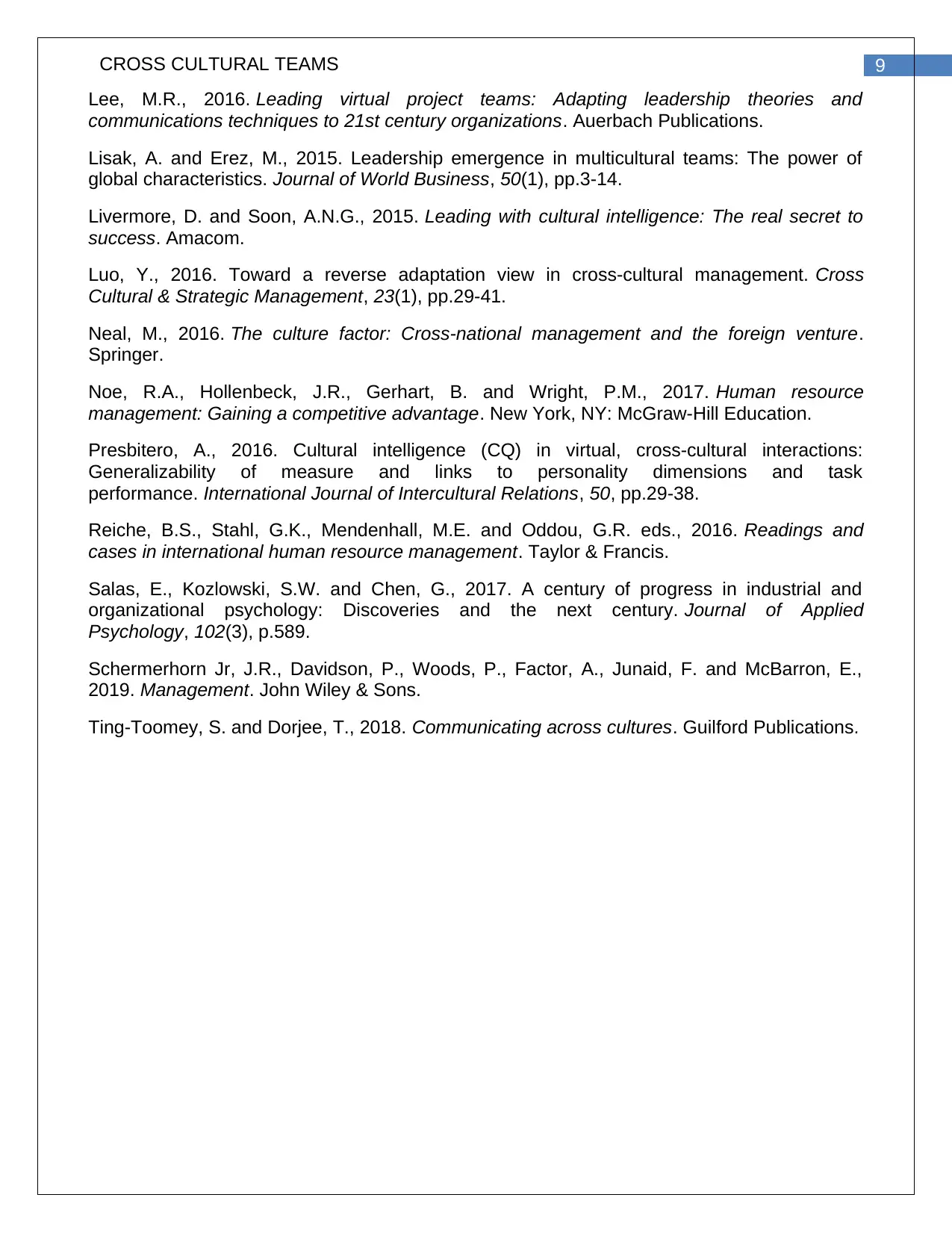
9CROSS CULTURAL TEAMS
Lee, M.R., 2016. Leading virtual project teams: Adapting leadership theories and
communications techniques to 21st century organizations. Auerbach Publications.
Lisak, A. and Erez, M., 2015. Leadership emergence in multicultural teams: The power of
global characteristics. Journal of World Business, 50(1), pp.3-14.
Livermore, D. and Soon, A.N.G., 2015. Leading with cultural intelligence: The real secret to
success. Amacom.
Luo, Y., 2016. Toward a reverse adaptation view in cross-cultural management. Cross
Cultural & Strategic Management, 23(1), pp.29-41.
Neal, M., 2016. The culture factor: Cross-national management and the foreign venture.
Springer.
Noe, R.A., Hollenbeck, J.R., Gerhart, B. and Wright, P.M., 2017. Human resource
management: Gaining a competitive advantage. New York, NY: McGraw-Hill Education.
Presbitero, A., 2016. Cultural intelligence (CQ) in virtual, cross-cultural interactions:
Generalizability of measure and links to personality dimensions and task
performance. International Journal of Intercultural Relations, 50, pp.29-38.
Reiche, B.S., Stahl, G.K., Mendenhall, M.E. and Oddou, G.R. eds., 2016. Readings and
cases in international human resource management. Taylor & Francis.
Salas, E., Kozlowski, S.W. and Chen, G., 2017. A century of progress in industrial and
organizational psychology: Discoveries and the next century. Journal of Applied
Psychology, 102(3), p.589.
Schermerhorn Jr, J.R., Davidson, P., Woods, P., Factor, A., Junaid, F. and McBarron, E.,
2019. Management. John Wiley & Sons.
Ting-Toomey, S. and Dorjee, T., 2018. Communicating across cultures. Guilford Publications.
Lee, M.R., 2016. Leading virtual project teams: Adapting leadership theories and
communications techniques to 21st century organizations. Auerbach Publications.
Lisak, A. and Erez, M., 2015. Leadership emergence in multicultural teams: The power of
global characteristics. Journal of World Business, 50(1), pp.3-14.
Livermore, D. and Soon, A.N.G., 2015. Leading with cultural intelligence: The real secret to
success. Amacom.
Luo, Y., 2016. Toward a reverse adaptation view in cross-cultural management. Cross
Cultural & Strategic Management, 23(1), pp.29-41.
Neal, M., 2016. The culture factor: Cross-national management and the foreign venture.
Springer.
Noe, R.A., Hollenbeck, J.R., Gerhart, B. and Wright, P.M., 2017. Human resource
management: Gaining a competitive advantage. New York, NY: McGraw-Hill Education.
Presbitero, A., 2016. Cultural intelligence (CQ) in virtual, cross-cultural interactions:
Generalizability of measure and links to personality dimensions and task
performance. International Journal of Intercultural Relations, 50, pp.29-38.
Reiche, B.S., Stahl, G.K., Mendenhall, M.E. and Oddou, G.R. eds., 2016. Readings and
cases in international human resource management. Taylor & Francis.
Salas, E., Kozlowski, S.W. and Chen, G., 2017. A century of progress in industrial and
organizational psychology: Discoveries and the next century. Journal of Applied
Psychology, 102(3), p.589.
Schermerhorn Jr, J.R., Davidson, P., Woods, P., Factor, A., Junaid, F. and McBarron, E.,
2019. Management. John Wiley & Sons.
Ting-Toomey, S. and Dorjee, T., 2018. Communicating across cultures. Guilford Publications.
1 out of 10
Related Documents
Your All-in-One AI-Powered Toolkit for Academic Success.
+13062052269
info@desklib.com
Available 24*7 on WhatsApp / Email
![[object Object]](/_next/static/media/star-bottom.7253800d.svg)
Unlock your academic potential
Copyright © 2020–2025 A2Z Services. All Rights Reserved. Developed and managed by ZUCOL.





